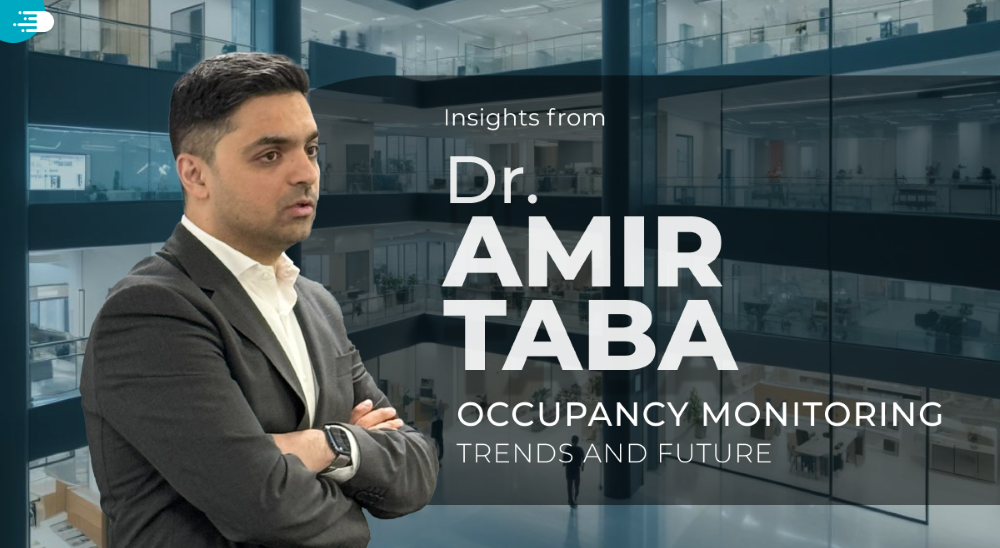The Future of Smart Buildings: Trends in Occupancy Monitoring

Occupancy monitoring technology is transforming the way we manage and utilise building spaces. With advancements in AI and IoT, this technology is becoming more sophisticated and integral to smart building management. This article will explore the current trends and prospects of occupancy monitoring, featuring insights from DR. Amir Taba, CEO of DIREK LTD on how these innovative technologies are shaping the industry.
Current Trends in Occupancy Monitoring
AI and IoT Integration
The integration of Artificial Intelligence (AI) and the Internet of Things (IoT) is significantly transforming occupancy monitoring. AI algorithms analyse data collected by IoT sensors to provide real-time insights into space utilisation, energy consumption, occupant behaviour, and enhancing the efficiency of smart buildings. This combination facilitates automated adjustments in lighting, HVAC systems, and security protocols based on occupancy levels, promoting both convenience and energy efficiency. Innovations in AI edge processing and low-power AI chips indicate a trend towards more efficient and localised data processing in these systems.
Enhanced Data Analytics
Modern occupancy monitoring systems use enhanced data analytics, leveraging big data and AI to offer deeper insights into space utilisation. Modern systems collect vast amounts of data from sensors and use machine learning algorithms to predict occupancy patterns, optimise space usage, and improve resource management. These analytics enable more precise control over building systems, reducing energy consumption, and improving operational efficiency. The trend is moving towards integrating these analytics with centralised IoT management platforms, which streamline data collection and processing, leading to smarter, more responsive environments.
Energy Efficiency and Sustainability
Occupancy monitoring systems are crucial in driving energy efficiency and sustainability in modern buildings. By accurately tracking occupancy, these systems ensure that energy is used only when necessary, reducing waste and lowering carbon footprints. Smart sensors and AI-driven analytics optimise the operation of HVAC systems, lighting, and other building services based on real-time occupancy data. This focus on sustainability is part of a broader trend towards creating greener, more energy-efficient smart cities.
Privacy and Security Enhancements
With the increasing deployment of IoT devices for occupancy monitoring, privacy and security have become important. Enhanced encryption, rigorous security protocols, and continuous monitoring powered by AI are now standard practices to safeguard data integrity and protect against breaches. Blockchain technology is also being explored to enhance the security of data transactions across IoT networks. These measures are essential to maintaining the trust and reliability of occupancy monitoring systems as they become more pervasive in smart buildings and cities.
DIREK’s CEO Insights
Vision for the Future
It is now a common understanding among business owners that not incorporating AI into their operations within the next two years will lead to a significant competitive disadvantage. This sentiment extends to IoT service providers in the building sector. Traditional sensors and actuators are evolving into smarter devices, playing increasingly pivotal roles in enhancing building operations efficiency. The prevailing trend is to fuse AI with IoT to ensure optimal utilisation of building resources, especially in areas previously difficult to manage. The immense data generated by IoT devices regarding building environments, occupancy, and appliance usage now allows AI models to predict future states and identify inefficiencies.
Data analytics, a critical output of IoT solutions, is transforming facility management. While facility managers are recognising the value of sensor data, the challenge remains in effectively harnessing this data. Analytics must be presented in a manner that is easily accessible and understandable, enabling facility managers to make informed decisions. This requires sophisticated data visualisation tools and user-friendly interfaces that can interpret complex datasets.
The integration of IoT and AI solutions will significantly impact energy consumption and sustainability in buildings. Lighting continues to be a major energy consumer. Current PIR-based lighting management solutions are being replaced with indoor radar systems that provide real-time occupant location data, leading to substantial energy savings. HVAC systems, the second largest energy consumers in buildings, can achieve 20-30% energy savings by adjusting their operation based on occupancy patterns and dynamics. Advanced control systems that model airflow dynamics can further enhance energy efficiency while improving occupant comfort and wellbeing. These systems leverage AI algorithms to predict and adjust to environmental changes in real-time, ensuring optimal performance and energy utilisation.
Challenges and Opportunities
One of the primary challenges in adopting new technologies is the cost, particularly the cost of sensors and their installation. Creative financing solutions, such as carbon saving credits, could offset these costs and accelerate the adoption of AI and IoT technologies.
Another significant challenge is the prevalence of proprietary products from major vendors, which do not interoperate with other systems. This limitation reduces options for end users and increases costs. However, this challenge presents an opportunity for innovative solution providers to bridge the gap by using open and interoperable protocols like MQTT, IFTTT, and BACnet. These protocols enable seamless integration of disparate systems, enhancing overall efficiency and functionality.
Advice for Industry Stakeholders
The building construction and management industry is traditionally risk-averse with tight profit margins. Despite this, the substantial ROI offered by innovative AI and IoT solutions cannot be ignored. Many companies now offer free or low-cost trials, providing an opportunity for stakeholders to evaluate the benefits without significant upfront investment. The ultimate message for industry stakeholders is clear: investing in AI for building management is not just beneficial but essential. Failure to do so could result in significant competitive disadvantages.
CEO’s background
Dr. Amir Taba, CEO of DIREK LTD, brings 15 years of expertise in applied machine learning, AI, positioning systems, and building management systems. Dr. Taba holds a PhD in electronics and has been a senior research fellow at the 6G Innovation Centre. His extensive experience and leadership at DIREK drive the company’s innovative approach to integrating AI and IoT in building management.
Read more about Space Optimisation and Occupancy Monitoring Technologies at www.direk.io
Conclusion
Occupancy monitoring technology is paving the way for the future of building management, driven by AI and IoT integration, enhanced data analytics, and a focus on energy efficiency and sustainability. These advancements are revolutionising how we manage spaces, making buildings smarter and more responsive.
Dr Amir Taba, CEO of DIREK LTD, envisions a future where AI and IoT are indispensable in optimising building operations. His insights highlight the necessity of adopting these technologies to stay competitive. By leveraging real-time data and predictive analytics, buildings can achieve substantial energy savings and improved occupant comfort.
Despite challenges such as costs and system interoperability, the potential benefits of these technologies are immense. Innovative solutions and open protocols offer a path forward, making advanced building management accessible and effective.
Investing in AI and IoT is not just a smart choice; it is essential for leading in the modern landscape of smart buildings. Dr Taba’s vision underscores the transformative impact these technologies will have, ensuring a sustainable, efficient, and technologically advanced future for building management.
For a deeper understanding of the fundamentals of occupancy monitoring, refer to the article: “Understanding Occupancy Monitoring: Essential Insights for Modern Smart Building Management.” at https://www.direk.io/post/703
